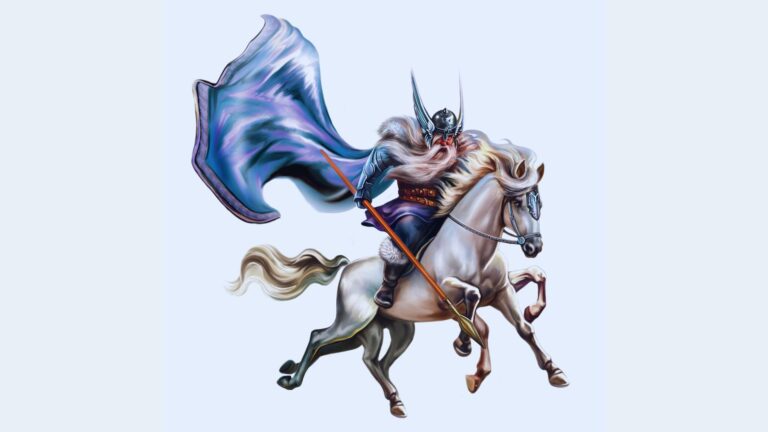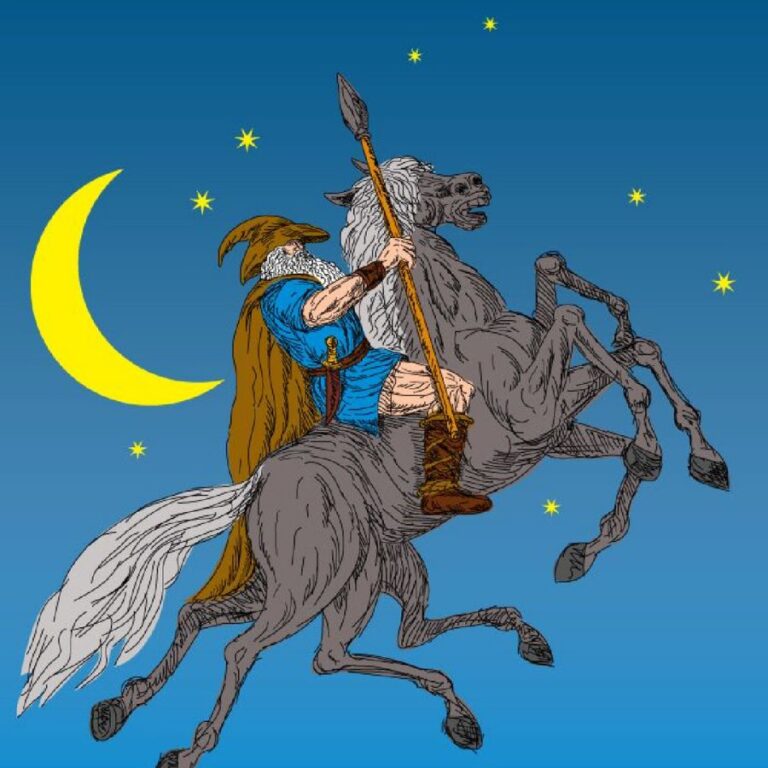Dive into the enchanting world of Norse mythology and uncover the intriguing tales of Sleipnir, Odin's extraordinary eight-legged steed.
Known for his unparalleled speed and unique origins, Sleipnir stands out as one of the most fascinating creatures in the Norse pantheon. This mythical creature is a symbol of divine power and an essential companion to Odin, the All-Father.

Sleipnir’s story is woven with themes of magic, loyalty, and the supernatural, captivating those who delve into the ancient tales of the Norse gods. Here are five captivating facts about this mythical steed.
1. The Extraordinary Birth of Sleipnir
Sleipnir's origins are as extraordinary as the horse himself, weaving a tale that showcases the depth and complexity of Norse mythology.
He was born from the union of Loki, the shape-shifting trickster god known for his cunning and unpredictability, and Svaðilfari, a powerful and impressive stallion.
The story begins with the gods of Asgard seeking to fortify their realm against potential threats. A master builder appeared and proposed to construct an impenetrable wall around Asgard, a feat that promised unparalleled security.
However, the builder's terms were steep: in exchange for his services, he demanded the goddess Freyja, along with the sun and the moon. The gods, eager but cautious, reluctantly agreed to his terms, with the condition that the wall must be completed within a single winter.
As the builder worked tirelessly, it became evident that he was making swift progress, thanks largely to the remarkable strength and endurance of his stallion, Svaðilfari.
Fearing that the builder might actually succeed and claim his exorbitant prize, the gods grew anxious. In their desperation, they turned to Loki, whose cleverness and trickery were often a double-edged sword, capable of both saving and jeopardising the gods.
Loki devised a plan to thwart the builder. Transforming himself into a beautiful mare, Loki lured Svaðilfari away from his duties. The stallion, entranced by the mare, abandoned the construction site and chased after her into the wilderness.
With the loss of his invaluable helper, the builder could not complete the wall in time, thereby forfeiting his claim to Freyja, the sun, and the moon.

However, Loki's plan had unforeseen consequences. His transformation and subsequent dalliance with Svaðilfari led to him becoming pregnant. In due time, Loki gave birth to an extraordinary foal with eight legs, a creature that would come to be known as Sleipnir.
This miraculous birth not only emphasised Loki's ability to transcend traditional boundaries but also introduced Sleipnir as a significant and powerful figure within Norse mythology.
2. Sleipnir Has a Unique Appearance
Sleipnir is unmistakable due to his eight legs, which set him apart from any other horse in the mythological or natural world.
These additional limbs grant him extraordinary speed and agility, allowing him to travel effortlessly between the nine realms of Norse Mythology.
In many modern interpretations of Sleipnir, the horse is shown to be of a muscular, almost skeletal, build.
His appearance symbolises the power and majesty of the gods, with his eight legs representing a connection to the divine and the supernatural. Sleipnir's unique form emphasises the Norse belief in the extraordinary and the otherworldly.
3. Slepnir is Odin's Trusted Mount
As the steed of Odin, the All-Father and chief of the Æsir, Sleipnir plays a crucial role in many myths. He is not just a means of transportation but a loyal companion and symbol of Odin's authority and power.
With Sleipnir, Odin can traverse the vast expanse of the cosmos, visiting distant realms such as Midgard (the world of humans) and Helheim (the realm of the dead), as well as venturing into the far reaches of Jotunheim (the land of giants) and beyond.
Sleipnir's ability to navigate these different worlds makes him an essential figure in the mythological tales, reinforcing Odin's omnipresence and wisdom, and underscoring the interconnectedness of the Norse world.
4. Sleipnir in the Myth of Baldr
One of Sleipnir's most notable appearances is in the myth of Baldr's death. After the beloved god Baldr is killed, his spirit is sent to the underworld.
Hermod, another son of Odin, rides Sleipnir to Helheim to plead with Hel, the ruler of the dead, for Baldr's return. This journey underscores Sleipnir's ability to move between life and death, emphasizing his role as a bridge between the worlds.
Sleipnir's involvement in this poignant tale highlights his significance in the mythology and his connection to the themes of life, death, and rebirth.
5. Sleipnir's Symbolism and Lasting Legacy
Sleipnir's legacy extends beyond mythology into various aspects of Norse culture and modern interpretations. He symbolises strength, endurance, and the ability to transcend ordinary limits.
His eight legs are often seen as representing the eight directions of the compass, signifying his capability to reach every corner of the universe.
Sleipnir's imagery can be found in ancient Norse art and continues to inspire contemporary representations in literature, film, and art.

